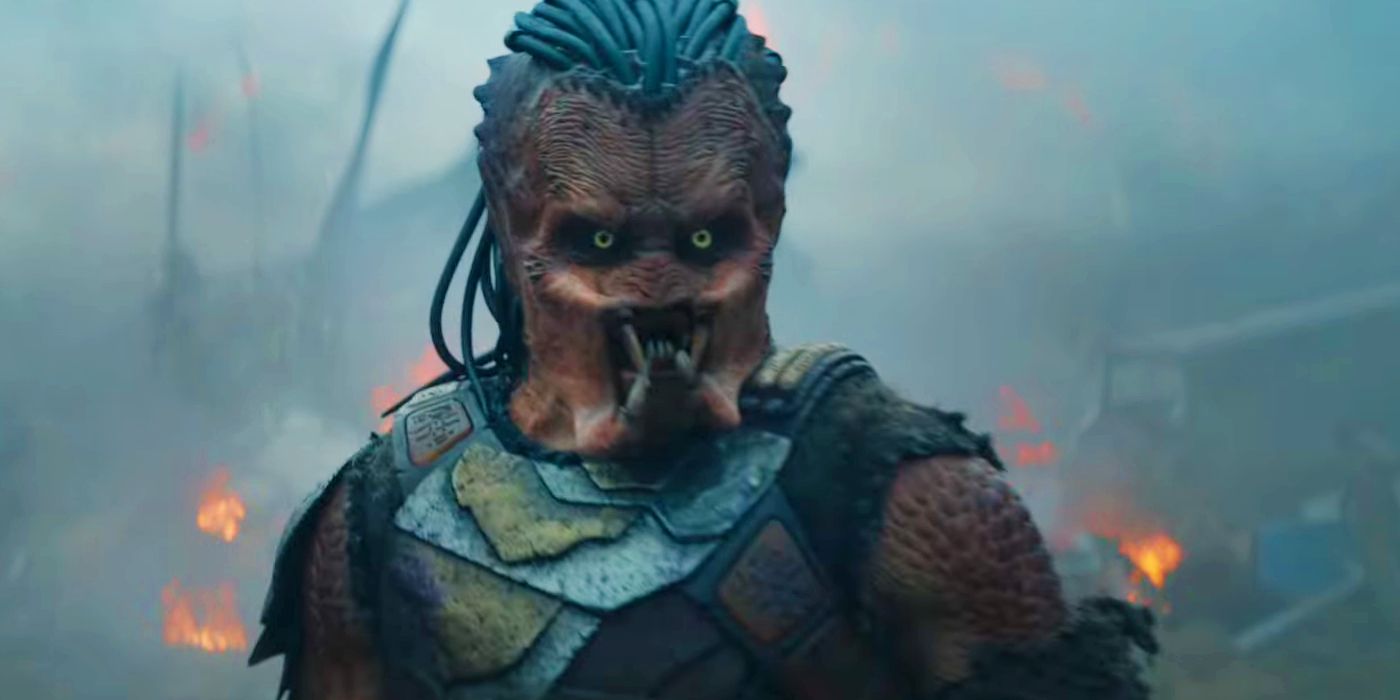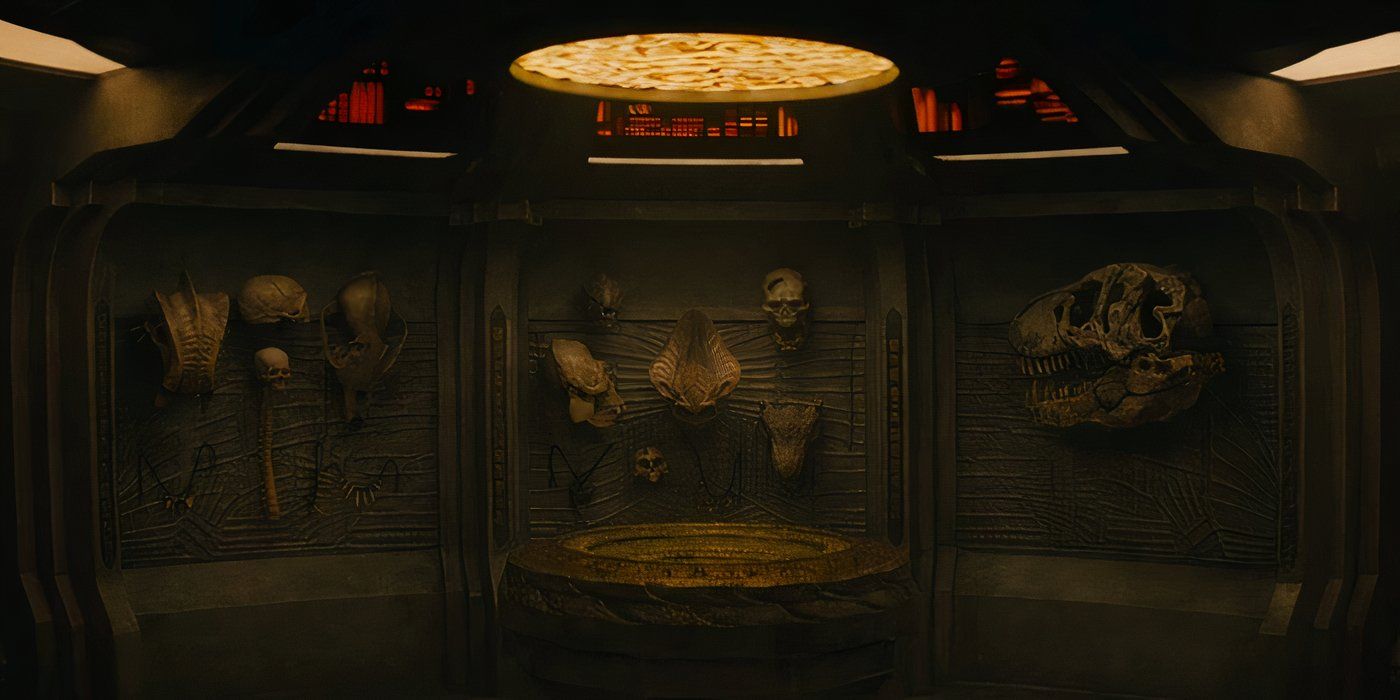Predator: Badlands director Dan Trachtenberg discussed the upcoming sci-fi film with members of the press (including Screen Rant) during an edit bay visit. The follow-up to the critically acclaimed (and generally pretty awesome) Prey, Trachtenberg decided to venture far away from the grounded Earth setting of that film to focus on a far more sci-fi style of Predator movie. Focused on a single member of the Yautja named Dek as he sets out to seemingly hunt an impossible target, Predator: Badlands looks to be a singular cinematic experience.
That was very much the intent, as Trachtenberg described the lengths he and the rest of the filmmakers involved in the project to make the movie as compelling and exciting as possible. During a conversation with members of the press attended by Screen Rant, Predator: Badlands director Dan Trachtenberg discussed the surprising inspirations on the film, the process of building an entire unique language for the franchise, and what separates the movie from other entries in the Predator franchise.
The Importance Of Restraint While World-Building For Predator: Badlands
“When People Hear The Premise, They May Think This Is Going To Be All About The Inner Workings Of The Yautja Culture. That’s Not What We Want To Do.”
The film’s deliberate focus on one of the Yautja necessitated some natural changes to the filmmaking approach. Chief among them was the language barrier that exists, as the Predators have never been portrayed speaking English. Rather than risk removing some of the naturally alien element of the characters, it was important to Trachtenberg that the Predators feel like their own unique culture and race — including their own language. “We decided to really treat that properly.“
“We reached out to the guy who does the Navi language [for Avatar], who was very occupied, and recommended his mentee. We did it the way that The Lord of the Rings does Elvish or Game of Thrones does Dothraki. Except with those, there’s more of a precedent. As we discovered with that language expert… [the Yautja language] in the other Predator movies is complete nonsense. There’s no sense to it. People from the internet have tried to make sense of it, but none of it was made with intention. So we decided to make it with intentions.”
“We completely developed the language. Everything they’re speaking has actual rules and structure and all that was written as verbal. Early on, we just did explorations with concept art of what we could do.” That commitment to the worldbuilding can be felt in the film’s expansion of the customs and technology of the Predators, fleshing out the setting without getting too distracted by it. That was a clear mission statement from Trachtenberg, who was adamant that the film not become too lore-focused at the expense of a compelling story.
“I think lots of times, when people do more in a franchise, there’s a tendency to go into the Senate trading committees,” Trachtenberg joked. “I thought we… should have a sliver of that, but not let the movie be that. When people hear the premise, they may think this is all about the inner workings of the Yautja culture. That’s not what we want to do. This is an invention of the premise. Now the Predator is on a planet, and he’s going to be hunted by things, and he has to use his guile to figure stuff out.”
Creating A New Kind Of Predator For Badlands
“It’s Still A Little Different Than When You See A Fully CG Gollum Or Any Alien Creature.”
At the center of Predator: Badlands is Dek, a young member of the Yautja who finds himself on a wildly dangerous world hunting impossible beasts. As a result, much of the film had to be filmed with extensive CGI, including some of the Yautja themselves. While every previous version of the Predator has been largely practical effects, the extensive acting Dek gets in the film as the protagonist required a lot of handover between the practical and the digital.
Describing the time and craft paid to making sure Dek’s suit felt natural and believable, Trachtenberg emphasized that much of the costume was constructed with practical effects, make-up, and costume design. However, “it’s still a little different than when you see a fully CG Gollum or any alien creature.” This required the filmmakers to digitally enhance the alien face in post-production, allowing Dimitrius Schuster-Koloamatangi more freedom to play Dek.
Looking back at the filming process, Trachenberg revealed that Schuster-Koloamatangi was a perfect pick for the film. “We thought we would want a stunt guy. This was a real opportunity, because all of the other Predators needed to be like, 7.6 feet tall. It’s a very specific kind of person who isn’t often a trained stuntman. They just happen to be that size and they decide to get into this business. This was the first time I was like, ‘Oh! We can get a proper stunt guy to be our guy, who can move only ways he can move.”
“At one of our castings, we had a number of stunt guys, and then Dimitrius came up, the way he moved just ahead a great swashbuckler to it. He was just so cool. We set up a little physical obstacle course, and he did that. Then he did some dramatic stuff from the movie, and it was awesome. I was not prepared for it all.” According to Trachetenberg, Schuster-Koloamatangi fully threw himself into the process and even learned how to replicate the Predator language on his own.
After filming him, the production then brought the footage into post-production and added more iconic elements of the Predator face. “If something in the look didn’t quite hit what we need… we’re really in this process where we’re discovering how to animate a face. It’s very different than Gollum or even Planet of the Apes, because those are a one-to-one translation to a human face. [Yautja] have got these mandibles and stuff. We just discovered the other day, whenever Demetrius blinks, we might want to see the Predator blink. We might just want the eyebrow movement. Then we tried to make his smiles and his snarls work with the mandibles. It’s all been very tricky, and thankfully, we’re really finding our way through it.“
Elle Fanning’s Thia And Trachtenberg’s Inspiration For Predator: Badland’s Inspiration
“If You Want The Same Old Predator Experience, You Can Hit Play On Predator Or Prey… I Wanted To Give People A Brand New Thing.”
Because Predator: Badlands doesn’t incorporate any human language as the primary form of communication, much of the movie is told entirely through visuals and acting. This played into a longstanding desire of the filmmaker, who explained that “I’ve always been obsessed with whether I can make a movie with no words or as few words as possible. Prey, at one time, was going to have no words. Then, when we started words, we started enjoying the words we were writing. But it was still quite minimal.”
“This is structurally similar, there are a lot of words up front, and then it becomes pretty much a rollercoaster ride.” The shift in focus gives Predator: Badlands a distinct style and tone from the rest of the series, even as the story serves as an interesting parallel to Prey. Having learned to “be as efficient as possible” and “you can be provocative with less” on the set of Prey, Dan Trachtenberg also believes that the two films are fundamentally different. “It’s got the same kind of roots, but it starts to go into a different branch of proving oneself.“
If you want the same old Predator experience, you can hit play on Predator or Prey, any of the Predator movies. I wanted to give people a brand new thing. Hopefully, that will be enjoyed.
One of the most mysterious elements of Badlands is the inclusion of Elle Fanning’s Thia, who the trailer somewhat teases. “There’s a really unique hook to her character that is really exciting in the pairing of the two of them,” Trachtenberg hinted at. This desire to pair off a main character with a direct contrasting supporting character was inspired by videogames, with the director specifically citing Shadow of the Colossus as a direct inspiration for his filmmaking.
“You have a protagonist that is paired with someone else that provides color and connection. There’s the horse in Shadow of the Colossus, that is devastating when you play the game and the story happens. I was a little inspired by that, in terms of wanting to see the Predator with someone else. This kind of character, the opposite of him. He’s very laconic, she’s not. She’s capable in ways he’s not. But there’s also physically, she’s got a thing that I’m so excited for [everyone] to see.“
Dan Trachtenberg acknowledged something like Predator: Badlands was a “big swing.” However, that’s also exactly the kind of film Trachtenberg believes needs to be in theaters. “I think we’re in a time where this kind of movie is what drives ʙuттs in seats. People are like, ‘I want to have an experience that I’ve never had before.’ If you want the same old Predator experience, you can hit play on Predator or Prey, any of the Predator movies. I wanted to give people a brand new thing. Hopefully, that will be enjoyed.”
Predator: Badlands is scheduled to be theatrically released in the United States on November 7, 2025.







